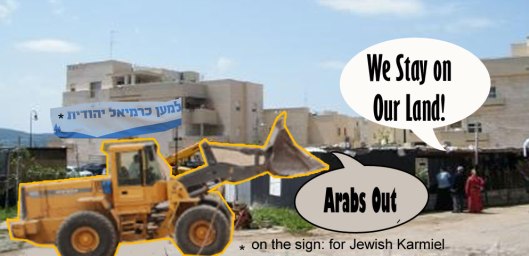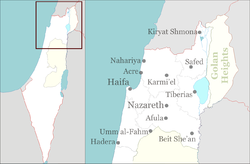Apartheid Bulldozers Threaten Ramiya’s Houses in Karmiel
 Thursday, January 2, 2014 at 11:26PM
Thursday, January 2, 2014 at 11:26PM http://freehaifa.wordpress.com/2013/12/13/apartheid-bulldozers-threaten-ramiyas-houses-in-karmiel/
Posted in Popular Struggle December 2013

Karmiel was born in sin – it was a cornerstone of the “Judaization of the Galilee” racist colonialist project.
It was built on large areas of land that were confiscated from nearby Arab towns and villages. This confiscation was not for development for “public purposes” – as claimed by the Israeli government’s confiscation orders – but in order to uproot the residents of the area, concentrate them in ghettos of poverty and settle in their place another public – exclusively those adhering to the Jewish religion.
Galilee Apartheid reality, represented by Karmiel, Misgav “communal” settlements, Nazareth Illit and their likes, does not end with the expropriation of land and its allocation according to racial criteria. Judaization is a comprehensive policy encompassing all aspects of life: discrimination in building infrastructure and providing services to residents; endless obstacles obstructing residential construction in Arab communities while encouraging Jewish settlement; blocking economic development in the Arab ghettos versus benefits and incentives to enterprises in the Apartheid towns.

Ahab and Naboth’s vineyard in Karmiel
The most outrageous illustration of Karmiel’s character as Apartheid City is the fate of the residents Ramiya, who live on their own land, which was lawfully registered in the Land Registry Office, long before the establishment of Karmiel.
When Ahab of Karmiel desired the vineyard of Naboth and his land, he was ready to use any means to get them.
Usually the legal excuse against unrecognized Arab villages, built on their private lands, is that they are built on agricultural land and therefore no building can be legalized there – even if it is an old building, standing there before the planning law itself. (For building Jewish settlements, of course, the designated usage of land is easily altered). But Ramiya’s lands are in the midst of Karmiel’s building areas. Why not recognize Ramiya’s houses as a separate village or as part of the city? The answer is obvious: because the city was founded for Jews – and Arabs should be evacuated.
A sweeping confiscation order against Ramiya’s lands was issued already in 1976 – on the grounds of “public needs” – at the height of the “Judaization of the Galilee” drive. After a long legal battle Israel’s “Supreme” Court upheld the expropriation on March 1, 1992.
But the abuse of Ramiya’s residents didn’t stop at the expropriation itself. In order to force the residents to give up their houses and lands, Karmiel’s Municipality and various state agencies wage a deliberate policy of siege and deprivation of basic needs against Ramiya’s residents, which can’t but remind us of the siege of Gaza.
One example that cries out to heaven is preventing Ramiya’s houses from connecting to the electricity grid.When residents bought generators, (who learns by candlelight these days?) the “good neighbors” complained about the generators’ noise. Instead of providing electricity to the residents, Karmiel’s Municipality sent inspectors to demand the shutdown of the generators at night and left Ramiya’s residents in the cold and dark.
Struggle and Agreement
In the early 1990s Ramiya became the center of the struggle against the Judaization of the Galilee. On one opportunity the central Land Day demonstration was held in Ramiya. Later there was a mass march from Majd al-Kurum to Ramiya.
Public pressure forced the Israel Lands Administration to agree to negotiations and finally reach a compromise, which was signed as an agreement with the residents in 1995.
The agreement, as signed, is far from doing justice. According to it the village will be destroyed and with it the existing fabric of life. The residents succumb to the racist expropriation forced upon them. It allows the state to take over the lands of Ramiya for a compensation that is a small fraction of their market value.
However, the agreement, to some extent, breaks the principle of Apartheid around which Karmiel was founded by enabling Ramiya residents to stay in the area and build their homes. To this end the Administration undertook to provide 30 building plots in a special neighborhood that will be built in Karmiel.
The agreement also included the provision of compensation to Ramiya residents in the form of 15 building plots and some farmland outside of Karmiel.
The Zionist Principle: More Land, Fewer Arabs
The Israel Lands Administration, which hurried before the agreement to try forcibly evict the residents, was in no hurry to fulfill the agreement.More than five years passed before it allocated the proposed land for resettlement of Ramiya’s residents in a new neighborhood of Karmiel.
The residents also were in no hurry to give up their homes and lands with which their lives’ stories were entwined.
Finally, between 2001 and 2003, the Administration began implementing the agreement in its own way: Take control of as much land as it can and allow as few Arabs as possible to remain in Karmiel. It signed an agreement for the evacuation of two families that possessed more land but had a smaller number of inhabitants and gave them about 35% of the land intended for the construction of the new neighborhood (which had shrunk meanwhile from 30 to 29 plots).
The Administration informed all other residents that they must make do with what was left. By doing so the administration is trying to force a reality which clearly does not maintain the minimum that was to be guaranteed by the settlement agreement – enabling Ramiya residents persist as a community and build their lives in their village.
The Shifting Sands of the Law
At this stage a legal miracle occurred for the residents of Ramiya.
Some residents had filed a lawsuit against the administration in the Haifa District Court, arguing that the administration had violated the settlement agreement. The ruling, issued by Judge Raniel on November 24, 2009 (civil case 699/07), confirms the claims of the plaintiffs that the Administration violated the agreement. Beyond that, the ruling states that “compliance with the agreement as it is, at the current state of affairs as of today, is not possible, given the unequal distribution carried out by the Administration. In this situation the agreement should be applied approximately. The administration should make adjustments in order to correct the distortion and inequality that were created and that the administration acknowledged their existence, by adding on the plots quotas agreed upon.”
Would you expect the Administration to rush to comply with the verdict and allow all Ramiya residents to build their homes in Karmiel? Not in Israel. We have seen it in many cases in the past, most famously in the case of displaced villagers of Bir’am, Iqrit and Ghabsiyah, where the Supreme Court issued orders allowing them to return to their lands. Even if “by mistake” an Israeli court issues a ruling recognizing some rights of Arab citizens, it is nothing but an unfortunate mistake to be fixed by another judicial ruling or directly in practice by the authorities.
In our case, the Administration made the petitioners who won their case to join other judicial proceeding dealing with the cases of other Ramiya residents, which was held in the same Haifa District Court. In this proceeding (civil case 35576/12/10), the Administration found a sympathetic ear in the form of judge Lamshtreich–Leter, which justified all the claims of the Administration, embraced all claims against the residents and even invented new arguments on her own behalf. In her judgment issued on August 5, 2013, contrary to custom, the judge ignored the previous verdict of judge Raniel issued at the very same court, and turned his ruling upside down.
Judge Lamshtreich–Leter was not content “only” to justify the theft of lands belonging to Ramiya residents and to order their deportation from Karmiel. She went farther and put forward her own militant agenda, ruling that any of the residents who would not sign an evacuation agreement with the Administration within 90 days (until November 4, 2013) shall be deemed to renounce voluntarily his rights within the framework of the 1995 settlement agreement and would have to evacuate the area immediately.
The residents filed an appeal against this draconian ruling in the Supreme Court (Civil Appeal 7198/13). The hearing of the appeal on its merits was not yet been held, but Judge Barak-Erez, in her decision of November 11, 2013, refused to grant suspension of execution of the evacuation until the hearing of the appeal and required the petitioners to pay the costs.
Divide and Rob
The most disgusting aspect of the authorities’ conduct in this context is their systematic efforts in sowing discord between Ramiya residents.
The method is simple: The Administration announced that the 30 plots allotted to the new neighborhood in Karmiel are the last offer for Ramiya’s people and that if any of the residents had no place to live this is an internal problem of the division between the residents.
Thus we see, unfortunately, some lawsuits by Ramiya residents against other residents.
When Judge Raniel ordered the Administration to allocate additional plots, the Administration completely ignored this directive.
On the other hand, judge Lamshtreich–Leter, in her ruling, adopts this quarrel-mongering tactic wholeheartedly and finds for it new justifications out of any context.
But the arbitrary and scandalous judgment, which denies the achievements of the residents in the agreement of 1995 and ordered their immediate evacuation without housing solutions, finally re-united the residents and re-ignited the public struggle over the principled issues, against racist evictions and land grab.
No to Apartheid – Yes to all Ramiya residents’ right to live in Karmiel
After decades of suffering and persecution, the drama in Ramiya is approaching the moment of truth.
Will forced evictions take place? Is the city of Karmiel determined to solidify its position as Apartheid City through a celebration of destruction and violence?
Or perhaps there is another way, allowing Ramiya residents at least to build homes in the neighborhood assigned for them in Karmiel? We repeat and mention that it is much less than justice – but definitely a crack in the walls of Apartheid…
Let us not forget that the struggle against dispossession and evictions in Ramiya takes place concurrently with the struggle against the “Prawer Plan” for ethnic cleansing against the Naqab (Negev) Bedouin and their concentration in ghettos, as well as similar dispossession and deportation programs in South Mount Hebron, the Jordan Valley and other areas. The guiding principle in all these cases and many others all over Palestine is the dispossession of the indigenous people on a racial basis, the theft of their lands and its re-allocation for the benefit of Apartheid Settlements.
You can help us in the struggle to stop Apartheid.
(see Action section for what you can do.)
 APJP |
APJP |  Post a Comment |
Post a Comment |
Reader Comments